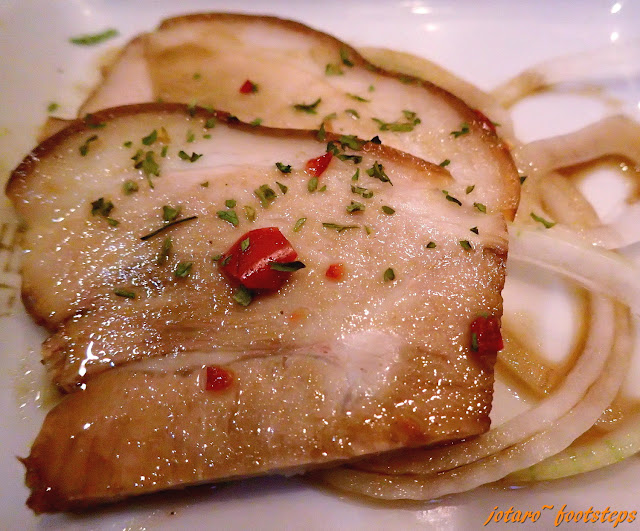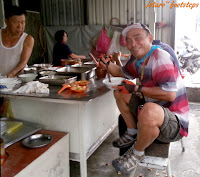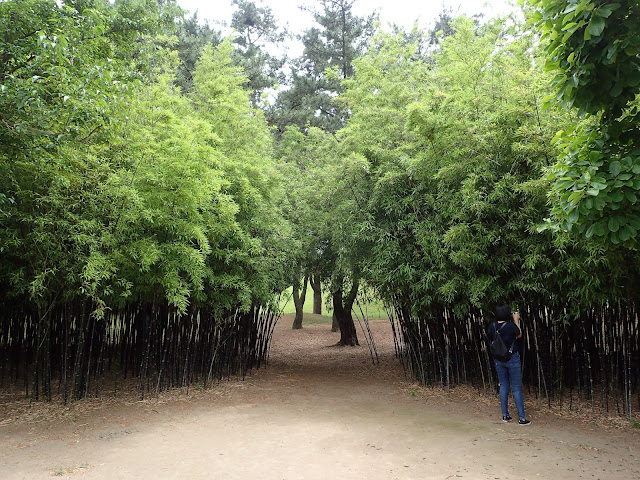You are at - Jotaro's Blog / FootSteps / YummY! / Korea 2016 - Korean Food / Traditional Gyeongju Korean Dinner @ Gyodongssambap
YummY!
Jotaro's Food Review
Traditional Gyeongju Korean Dinner @ Gyodong Ssambap (교동쌈밥)
On a cycling tour of Korea, we were looking for good Korean food while we where at Gyeongju. Our kind host of the Hanok Sodamjeong, Kim Eun-hee, gave us one of the best recommendations - Gyodong Ssambap that served authentic Gyeongju food with a strong touch of the subtle local flavours.
Like most buildings in Gyeongju, Gyodong Ssambap is housed in a very traditional looking building, one of pinewood walls and floors and curved roofs with prominent round rafters.
Inside, it was cosy with seating on regular chairs or on the timber floors around low tables. The prime location would be those at the front of the restaurant, with large windows that gave a good view of the tumuli across the road.
Gyodong Ssambap serves very localised Gyeongju fare with three main recommended dishes; we went for all three.
First off was the Tosok-Sshanjeongsik, yes the name is a mouthful to get out. Fortunately the menu have the written equivalent in English, so there was no problem in ordering. This dish comes with raw meat that is either barbecued or dip into a hot soup. The meat available are pork, duck and beef all marinated with bulgogi sauce. The minimum order is for two, which we went for as we would be ordering the other of their recommendations for the five of us. Having had had barbecue meat in several of our earlier Korean meals, we decided to go for the soup version.
We went for the beef and it had a very distinct name of "Gyeongju Millennium Hanwoo Bulgogi". We dipped it into the hot soup for and appropriate short while an started walloping! The meat was tender as expected of Hanwoo beef, and juicy too. The Bulgogi seasoning was very light, so light that it's flavour was just a tinge on the tips of our tongues. It was very good, as good as its distinct name.
Other than the usual kimchi side-dishes; this order came with some other interesting extras that had subtle and strong flavours ...
... like this Green Perilla Leaf salad. The leaves can be taken by itself, or wrapped around some meat or kimchi the ssam style; whichever way, it is a healthy food.
And this Smoked Pork Belly garnished with sprinklings of finely shredded chilli and parsley. It was flavourful with a fairly strong smoked flavour.
Another strong flavoured side-dish - Sardine & Radish Kimchi. The radish came in a huge chunk and the fishy taste balanced off the mild radish taste.
Well, this is a first for me in a Korean restaurant - mashed potatoes that came with a touch of sprinklings of black sesame; another balance dish of soft and strong flavours.
This dish called Yukbuchon-Yukgaejang has an interesting history. A bit of history lesson here - Yukbuchon refers to the six tribal villages in Seorabeol (that's the historic name of Gyeongju) which laid the foundations of the Korean Silla Empire. Yukbuchon-Yukgaejang means Six Tribal Villages Hot Shredded Beef Soup is a delicious royal style dish using six ingredients including Gyeongju Millennium Hanwoo beef, bracken ferns, gondalbi leafs (Ligularia Stenocephala) and beef intestines. The set came with very light side-dishes and a bowl of rice.
This is a close up look of the vegetable mix together with a bit of the beef. It looks like chop suey with kimchi (my apologies to the Six Tribal Villages); the looks does not seem appetising but it was really a good soup with a fair beef flavour and those healthy vegetables/herbs blend should do one good.
Next was a bibimbap of a different kind; it's called Gondalbi Bibimbap. This colourful dish consisted of friendly wild herbs, gondalbi leafs, button mushrooms and water parsley. Instead of Gochujang (red chilli powder), a condiment of powdered anchovies in soy-bean paste is used to flavour the dish. It's not the usual bibimbap and I liked it very much as its soft flavours contrasted the hot beef soup. The set came with light side-dishes, rice and a bowl of vegetable soup.
It was a good dinner, one that is off-the-beaten track with localised authentic dishes of contrasting flavours... and healthy too!
For the five of us, the bill came to 54,000KRW; reasonable for what can be considered as Korean fine dining.
Gyodong Ssambap (교동쌈밥)
328-1 Hwangnam-dong, Gyeongju, Gyeongsangbuk-do, South Korea.
Tel: +82 54-773-3322 | Mobile: +82 010-9351-5726
GPS: 35.83325, 129.21055
Related Blogs :
 |
 |
 |
You may also like :
 |
 |
 |
 |
 |
 |
 |
| Balik Pulau Street Art Wall Murals Interesting pieces of beautiful street art murals found at the rural town of Balik Pulau located at the other side of Penang Island. |
 |
 |
 |
 |
 |
 |
 |
You are at - Jotaro's Blog / FootSteps / YummY! / Korea 2016 - Korean Food / Traditional Gyeongju Korean Dinner @ Gyodongssambap
If you like this, view my other blogs at Jotaro's Blog
(comments most welcomed. if you like this pls share via facebook or twitter)
If you like this, view my other blogs at Jotaro's Blog
(comments most welcomed. if you like this pls share via facebook or twitter)



























































